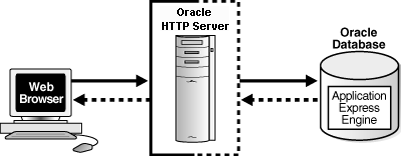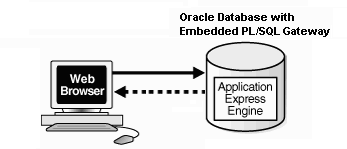
Previous

Next
Home > Introducing Oracle Applicat... > Understanding Oracle Applic...
 Previous |
 Next |
Oracle Application Express installs with your Oracle database and is comprised of data in tables and PL/SQL code.
Whether you run the Oracle Application Express development environment or an application you built using Oracle Application Express, the process is the same. Your browser sends a URL request that is translated into the appropriate Oracle Application Express PL/SQL call. After the database processes the PL/SQL, the results are relayed back to your browser as HTML. This cycle happens each time you request or submit a page.
The application session state is managed in the database tables within Oracle Application Express. It does not use a dedicated database connection. Instead, each request is made through a separate database session, consuming minimal CPU resources.
About Oracle Application Express Listener, Oracle HTTP Server (Apache), and the Embedded PL/SQL Gateway
The version of Oracle Database you use determines how the URL is translated:
Versions prior to Oracle Database 11.1 require Oracle Application Express Listener or Oracle HTTP Server (Apache) with mod_plsql. The following graphic illustrates the three-tier architecture.

With Oracle Database 11.1 or later or Oracle Database 10g Express Edition, you can use the embedded PL/SQL gateway. The following graphic illustrates the two-tier architecture using the embedded PL/SQL gateway.

The embedded PL/SQL gateway provides the Oracle database with a Web server and also the necessary infrastructure to create dynamic applications. The embedded PL/SQL gateway runs in the XML DB HTTP server in the Oracle database and includes the core features of mod_plsql. Inclusion of the embedded PL/SQL gateway simplifies the architecture and eliminates the middle tier entirely.
|
See Also: "Understanding Administrator Security Best Practice" in Oracle Application Express Application Builder User's Guide |
About the Application Express Engine
The Application Express engine renders and processes pages. It also performs these tasks:
Session state management
Authentication services
Authorization services
Page flow control
Validations processing